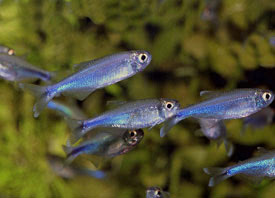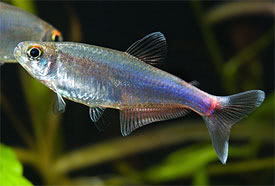
 Magyarul / Hungarian
Magyarul / Hungarian



- Scientific name: Knodus borki
- Synonyms: -
- Common name:
- Group: Characins
- Habitat: South America; Peru (surroundings of Iquitos), Colombia, Brazil
- Size: 5 cm
- Biotope: Rivers and small streams.
- Social behavior: A generally peaceful and active shoaling fish. Can be kept in a biotope aquarium with fish which like similar conditions. They may occasionally nip at the fins of other species with elongated fins.
- Diet: Omnivorous; small live and frozen foods, some vegetable matter or spirulina flakes.
- Breeding: Hard
- Tank: Minimum 90 litres
- Population: 6-8 fishes for 120 litres
- Decoration: Best kept in a heavily-planted aquarium with dark substrate, Add some floating plants to the tank to dim the lighting. You can add some aquarium-safe peat to the water.
- Temperature: 22-26°C
- pH: 5.5-7
- Hardness: 5-12 NK°
- Lifespan: 3-4 years
Description: The Blue tetra (Boehlkea fredcochui) has been misidentified and the fish that has been appearing under this name for 40 years in the ornamental fish trade is actually an undescribed species. This misidentified species has been described by German ichthyologist Axel Zarske (after the German aquarist Dieter Bork). Both species differ mainly in the dentition of maxillary bone (3-4 tricuspid or conical teeth in Knodus borki vs. 11-21 tricuspid or conical teeth in Boehlkea fredcochui and in coloration: Boehlkea fredcochui with a black bar-like mark at the caudal-fin base absent in Knodus borki; Boehlkea fredcochui with a dark longitudinal stripe from the gill cover to the base of the caudal fin while Knodus borki has a faint dark stripe beginning below the dorsal fin and extending to the middle caudal-fin rays. Boehlkea fredcochui has a white spot on the tip of the dorsal fin. The color of Knodus borki is often so intense that many who first see it for sale assume it to be artificially colored.
Mature females have rounder bellies, while males have a little more intensely color and their anal fin is often become reddish when in spawning condition. Breeding is possible in a smaller (15 litres) separate spawning tank with soft, acidic, aged water. The female is usually lay her eggs under a broad plant leaf, so put some Amazon swords or similar to the tank. Before breeding condition the fish in a group with plenty of high quality live and frozen foods. After a few days place the pair in the spawning tank in the evening. They should spawn in the next morning. After that, the parents should be removed as they may eat the eggs. The fry are very small and require infusoria as a first food.







































